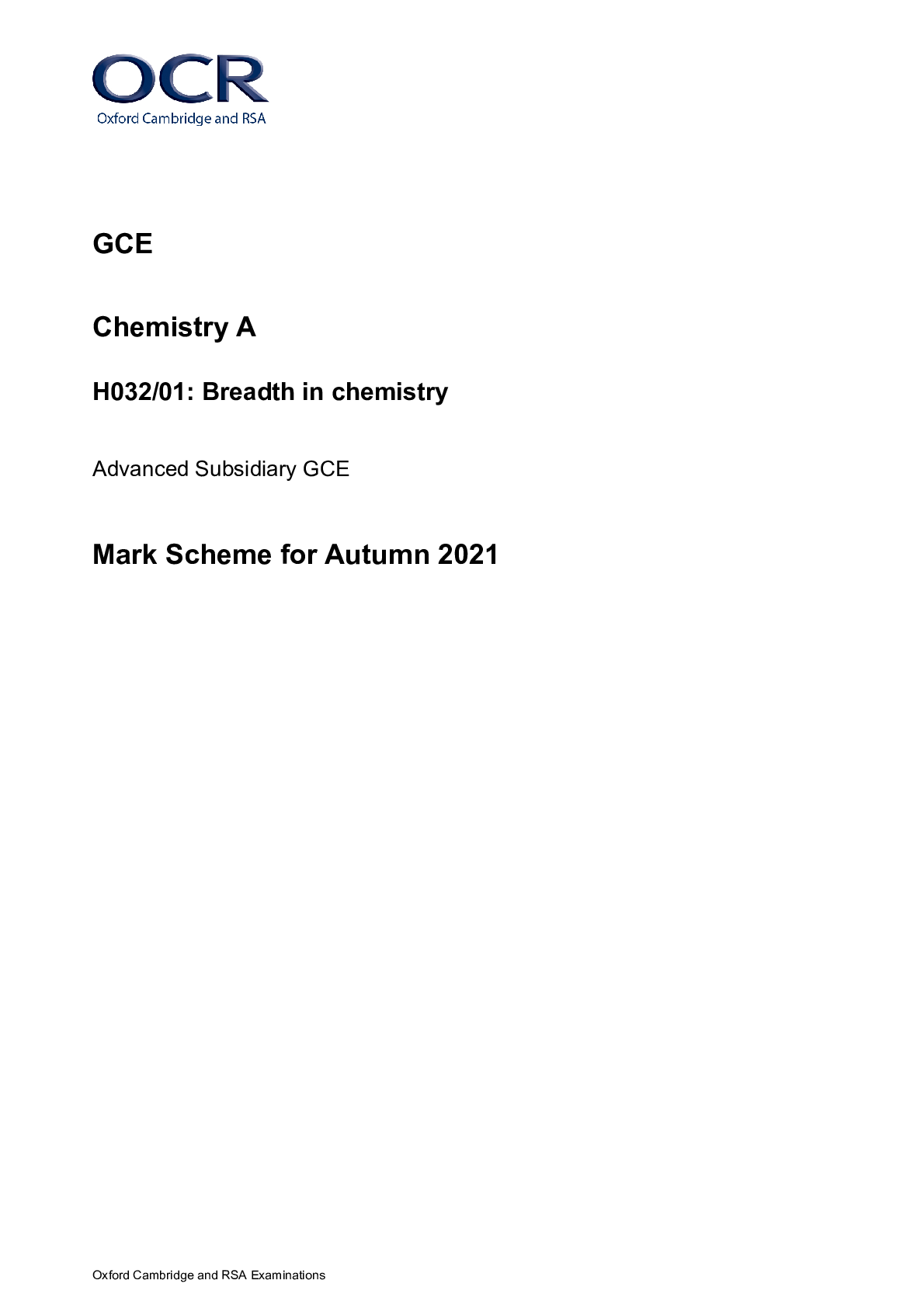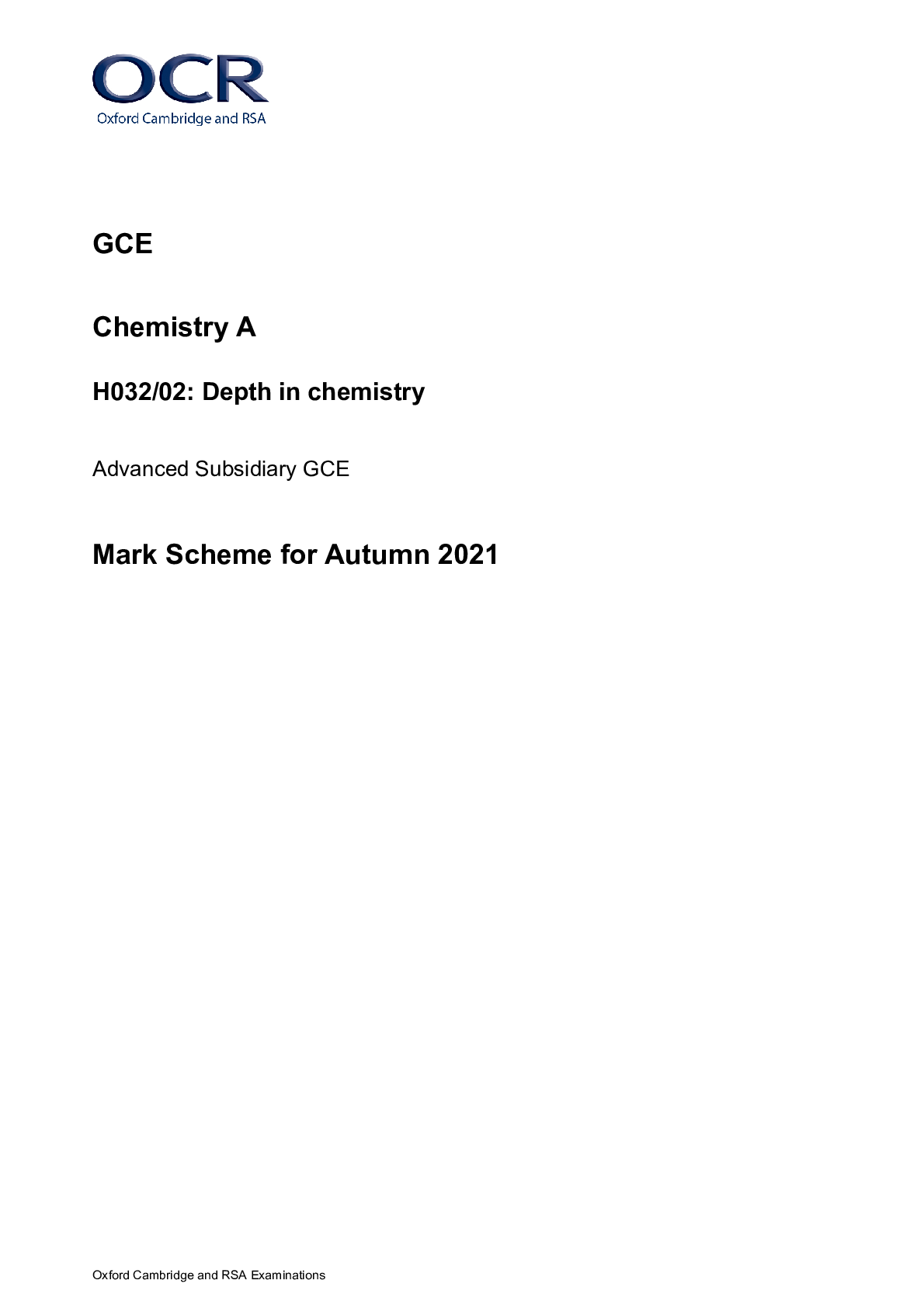Chemistry > GCSE MARK SCHEME > GCE Chemistry B H033/02: Chemistry in depth Advanced Subsidiary GCE Mark Scheme for November 2020 (All)
GCE Chemistry B H033/02: Chemistry in depth Advanced Subsidiary GCE Mark Scheme for November 2020
Document Content and Description Below
GCE Chemistry B H033/02: Chemistry in depth Advanced Subsidiary GCE Mark Scheme for November 2020 Oxford Cambridge and RSA Examinations GCE Chemistry B H033/02: Chemistry in depth Advanced Subs... idiary GCE Mark Scheme for November 2020Oxford Cambridge and RSA Examinations OCR (Oxford Cambridge and RSA) is a leading UK awarding body, providing a wide range of qualifications to meet the needs of candidates of all ages and abilities. OCR qualifications include AS/A Levels, Diplomas, GCSEs, Cambridge Nationals, Cambridge Technicals, Functional Skills, Key Skills, Entry Level qualifications, NVQs and vocational qualifications in areas such as IT, business, languages, teaching/training, administration and secretarial skills. It is also responsible for developing new specifications to meet national requirements and the needs of students and teachers. OCR is a not-for-profit organisation; any surplus made is invested back into the establishment to help towards the development of qualifications and support, which keep pace with the changing needs of today’s society. This mark scheme is published as an aid to teachers and students, to indicate the requirements of the examination. It shows the basis on which marks were awarded by examiners. It does not indicate the details of the discussions which took place at an examiners’ meeting before marking commenced. All examiners are instructed that alternative correct answers and unexpected approaches in candidates’ scripts must be given marks that fairly reflect the relevant knowledge and skills demonstrated. Mark schemes should be read in conjunction with the published question papers and the report on the examination. © OCR 2020Annotations Annotation Meaning Correct response Incorrect response Omission mark Benefit of doubt given Contradiction Rounding error Error in number of significant figures Error carried forward Level 1 Level 2 Level 3 Benefit of doubt not given Noted but no credit given IgnoreAbbreviations, annotations and conventions used in the detailed Mark Scheme (to include abbreviations and subject-specific conventions). Annotation Meaning DO NOT ALLOW Answers which are not worthy of credit IGNORE Statements which are irrelevant ALLOW Answers that can be accepted ( ) Words which are not essential to gain credit __ Underlined words must be present in answer to score a mark ECF Error carried forward AW Alternative wording ORA Or reverse argumentH033/02 Mark Scheme November 2020 4 Question Answer Mark AO element Guidance 1 (a) 1 2.1 ALLOW other correct representations. 1 (b) (i) 1 1.1 Labelling of π-bond not essential for mark Precise shape of π-bond not essential, though must be both above and below labelled σ-bond ALLOW, for example, the following shape (filled or open) 1 (b) (ii) (It represents) a bond (in a direction) in front of (the plane of) the paper 1 1.1 ALLOW (coming) out of (the plane of) the paper 1 (c) (i) H2C C C CH2 H H n 1 2.1 ALLOW CH instead of the displayed C-H bonds ALLOW CHCH for double bond ALLOW without bracket and/or n 1 (c) (ii) 1 2.1 ALLOW other correct representations. ALLOW without bracket and/or n (c) (iii) Each carbon atom of the double bond has got two different groups attached 2 1.1 x2 H2C C C H H n CH2 ClH033/02 Mark Scheme November 2020 5 Question Answer Mark AO element Guidance There is no (free) rotation about a carbon-carbon double bond 1 (d) (i) Electrophilic Addition 1 1.1 1 (d) (ii) CH2=CHCH=CH12 + H Br → CH12=CHCHCH3 + BrCH12=CHCHCH3 + Br- → CH12=CHCHBrCH3 both curly arrows in Step 1 partial and full positive/negative charges shown) curly arrow in Step 2 3 1.2 x3 Curly arrows must start (when projected backwards) on the bond concerned OR the minus sign (or a shown lone pair) on the bromide. They must finish (when projected) at the atom concerned or point towards the bond being formed. Product not essential δ+ δ- + +H033/02 Mark Scheme November 2020 6 Question Answer Mark AO element Guidance 2 (a) BaCO3(s) + 2HCl(aq) → BaCl2(aq) + CO2(g) + H2O(l) equation + balancing states 2 2.2 x2 2 (b) (i) Experimental method (diagram with labels): Heat Group 2 carbonates AND pass gas through lime water. Valid test: Use same amount/moles of carbonate Idea of same heating intensity Observation: It takes longer to go cloudy for BaCO3 (than CaCO3) (ORA)/down the Group (AW) 4 1.2 3.3 3.3 2.3 Group 2 carbonate lime water Heated tube can be at an angle ALLOW white(precipitate)/milky/chalky for cloudy. ALLOW it goes less cloudy for BaCO3 (than CaCO3) (ora)/down the Group. 2 (b) (ii) (The student is incorrect in that) it is not because the (Group 2) metals become more reactive (going down the Group) It is because the (Group 2) cations have a lower charge density going down the Group (ORA) This causes less polarisation/distortion of the carbonate ion AND greater (thermal) stability (ORA) 3 3.1 1.1 1.1 ALLOW it is not to do with the reactivity of the (Group 2) metals ALLOW larger size to charge ratio. going down the Group ALLOW correct reference to specific examples to illustrate these MPs. 2 (c) (i) calcium = (brick) red 1 1.2 2 (c) (ii) Black lines AND at the same wavelengths/frequencies as the lines in the atomic emission spectrum 2 2.1 x2 ALLOW “lines in same places’ for ‘same wavelengths/frequencies’.H033/02 Mark Scheme November 2020 7 Question Answer Mark AO element Guidance on a background of the continuous spectrum/of visible light ALLOW on a coloured background 2 (c) (iii) FIRST CHECK THE ANSWER ON THE ANSWER LINE If answer = 3.21 x 10-22 (kJ) award 3 marks (ν = c/λ) ν = (3.00 x 108 / 6.20 x 10-7) = 4.84 x 1014 Hz (ΔE = hν) ΔE = (6.63 x 10-34 x 4.84 x 1014) = 3.21 x 10-19 J = 3.21 x 10-22 (Kj) 3 2.2 x3 ALLOW 2 or more sf 2 (d) (i) (0.06 / 25.0) x 100 = 0.24(%) 1 2.4 2 (d) (ii) FIRST CHECK THE ANSWER ON THE ANSWER LINE If answer = 1.73 (g dm-3) award 4 marks Amount of HCl (in mean titre) = (11.70 / 1000 x 0.100) = 1.17 x 10-3 mol Amount of Ca(OH)2 (in 15.0 cm3) = 1.17 x 10-3 / 2 = 5.85 x 10-4 mol Concentration Ca(OH)2 = (5.85 x 10-4 x 1000 / 25) = 0.0134 mol dm-3 Mr of Ca(OH)2 = 74.1 Concentration Ca(OH)1 = (0.0134 x 74.1) = 1.73 (g dm-3) 4 2.8 x4 ALLOW two or more sfH033/02 Mark Scheme November 2020 8 Question Answer Mark AO element Guidance 2 (e) The mean titre/it would be greater/larger (than 11.70 cm3). AND Barium hydroxide is more soluble than calcium hydroxide/Solubility increases down Group 2/the Group. 1 3.2 ALLOW (A) saturated (solution of) barium hydroxide has a higher concentration of hydroxide ions than that of calcium hydroxide.H033/02 Mark Scheme November 2020 9 Question Answer Mark AO element Guidance 3 (a) Sodium hydroxide reacts with both the phenol and carboxyl (functional) groups to give NaOC6H4COONa sodium carbonate only reacts with the carboxyl (functional) group to give HOC6H4COONa The carboxyl (functional) group is more acidic than the phenol (functional) group 3 3.1 3.1 2.5 ALLOW structures with ionic charges shown. ALLOW structures with benzene rings drawn. ALLOW the (sodium) carbonate is not a strong enough base to remove the hydrogen from the phenol group. 3 (b) (i) To prevent loss of reactants/products/mixture (by vaporisation) 1 1.2 3 (b) (ii) FIRST CHECK THE ANSWER ON THE ANSWER LINE If answer = 61 (%) award 3 marks 2.8 / [(3.5 / 138) x 180] x 100 = 61(%) [(3.5 / 138) x 180] calculation of % 2 s.f. 3 2.8 x3 61.3(3) DOES NOT score s.f. mark 3 (c) Ester 1 2.1 3 (d) The oxygen atom is more electronegative than the carbon atom AND the carbon to oxygen double bond is polar covalent pd-pd attractions (between Cδ+ and Oδ–) are strong/ not the strongest imbs The high melting point is due to the (stronger) hydrogen bonds between the carboxyl groups (in neighbouring molecules) 3 3.1 3.2 x2H033/02 Mark Scheme November 2020 10 Question Answer Mark AO element Guidance 3 (e) (Neutral) iron(III) chloride solution will give a purple colouration with (only) the 4-hydroxybenzoic acid 1 2.7 ALLOW ferric for iron(III) 3 (f) Dissolve the crude product in the minimum volume of hot ethanol (Filter to remove insoluble impurities). Allow the hot solution to cool. Filter to remove recrystallised product. Wash (the solid with cold solvent) AND dry. 4 1.2 x4 ALLOW ‘solvent’ for ‘ethanol’H033/02 Mark Scheme November 2020 11 Question Answer Mark AO element Guidance 3 (g)* Please refer to the marking instructions on page 5 of this mark scheme for guidance on how to mark this question. Level 3 (5-6 marks) Detailed description of how to produce a chromatogram (with some fine detail [italic]). AND Detailed explanation of what the results show. There is a well-developed line of reasoning which is clear and logically structured. The information presented is relevant and substantiated. Level 2 (3-4 marks) Detailed description of how to produce a chromatogram (with some fine detail [italic]). OR Describe in partial detail how the chromatogram is produced. AND Provide a partial explanation of what the results show. OR Detailed explanation of what the results show. There is a line of reasoning presented with some structure. The information presented is relevant and supported by some evidence Level 1 (1-2 marks) Describe in partial detail how the chromatogram is produced. OR Provide a partial explanation of what the results show. 6 1.2 x3 3.2 x3 Indicative Scientific points include: Description of how the thin-layer chromatogram is produced (fine detail in italic) • Draw a pencil line on tlc plate # • Line must come above solvent level # • Spot mixture and pure samples onto pencil line # • Place plate in a beaker of solvent # • Beaker covered # • Remove plate when solvent front is near to top of plate • Mark how far solvent has reached • Allow plate to dry • Locate any spots • with iodine or under a u.v. lamp (# can be achieved in a labelled diagram) Analysis of results of the experiment • Alkaline results/Fig 3.1 show some breakdown of paraben/4-acetyloxybenzoic acid after 1 week and even more after 1 month * • The amounts/spots of P decreases and B increases between 1 week and 1 month • Acidic results/Fig 3.2 show no breakdown after 1 week and some after 1 month. * • No B was produced after 1 week but amounts/spots of P decreases and B increases slightly between 1 week and 1 month * faster hydrolysis in alkaline than acidic (conditions)H033/02 Mark Scheme November 2020 12 Question Answer Mark AO element Guidance OR Detailed explanation of what the results show. There is an attempt at a logical structure with a line of reasoning. The information is in the most part relevant 0 marks No response or no response worthy of credit.H033/02 Mark Scheme November 2020 13 Question Answer Mar k AO element Guidance 4 (a) Thermal decomposition requires heat 1 3.4 ALLOW other reactions may occur 4 (b) FIRST CHECK THE ANSWER ON THE ANSWER LINE If answer = (+)20.9 (kJ mol-1) award 2 marks (q = mcΔT) q = 50.0 x 4.18 x 7.50 = 1.567.5 kJ ΔH = (+)(1 / 7.50 x 10-2) x 1.567.5 ΔH = (+)20.9 (kJ mol-1) 2 2.4 x2 ALLOW 20.9 without plus sign. ALLOW two or more sf Conversion of J to kJ can occur at any time.H033/02 Mark Scheme November 2020 14 Question Answer Mark AO element Guidance 4 (c) Please refer to the marking instructions on page 5 of this mark scheme for guidance on how to mark this question. Level 3 (5-6 marks) Detailed description of how to reduce measurement uncertainty AND reduce ‘heat losses’. AND some detail for the graphical method. There is a well-developed line of reasoning which is clear and logically structured. The information presented is relevant and substantiated. Level 2 (3-4 marks) Some description of how to reduce measurement uncertainty AND reduce ‘heat losses’. OR Detailed description of how to reduce measurement uncertainty OR ‘heat losses’ with some reference to the graphical method. There is a line of reasoning presented with some structure. The information presented is relevant and supported by some evidence Level 1 (1-2 marks) Outline description of how to reduce measurement uncertainty. OR Outline description of how to reduce ‘heat losses’, OR Outline description for the graphical method. There is an attempt at a logical structure with a line of reasoning. The information is in the most part relevant. 6 3.3 x3 3.4 x3 Indicative Scientific points include: Making measurement uncertainty smaller • Use a 50.0 cm3 pipette/measuring cylinder • Use a thermometer of greater precision/to the nearest 0.5 or 0.1 °C • Use a balance weighing to 0.01g Making ‘heat losses’ smaller • Use a polystyrene beaker • lid on beaker (loose fitting – gas is evolved) • Stir throughout Graphical method (points can be achieved in words or by sketching graph) • Continue to record temperature every minute/half minute until temperature starts to fall again • Extrapolate cooling line • Read the theoretical maximum temperature change at the time when the reactants were mixedH033/02 Mark Scheme November 2020 15 Question Answer Mark AO element Guidance 0 marks No response or no response worthy of credit. 4 (d) FIRST CHECK THE ANSWER ON THE ANSWER LINE If answer = (+)76 (kJ mol-1) award 3 marks 2NaHCO3(s) Na2CO3(s) + CO2(g) + H2O(l) 2NaCl(aq) + 2CO2(g) + 2H2O(l) (for Hess’ law enthalpy cycle) ΔH1 = 2ΔH2 – ΔH3 (for correct relationship between the three ΔH terms) ΔH1= 2(+23) – (-30) ΔH1= (+)76 (kJ mol-1) 4 2.4 x4 ALLOW 76 without sign Award the mark for the Hess’ law enthalpy cycle separately to the three marks for the calculation. The ∆H values do not need to be included to achieve the mark for the Hess cycle as they occur in MP2. They are left in the cycle here to assist the marker. 4 (e) FIRST CHECK THE ANSWER ON THE ANSWER LINE If answer = (+)463.5/464 (kJ mol–1) award 2 marks 4O-H – 1370 = 484 O-H = + 463.5/464 (kJ mol–1) 2 2.2 x2 ALLOW number without sign 4 (f) NaHCO3 (and Na2CO3) ionic so not all bonds are covalent (AW) 1 3.2 + 2HCl + 2HCl ΔH1 2ΔH2 ΔH3OCR (Oxford Cambridge and RSA Examinations) The Triangle Building Shaftesbury Road Cambridge CB2 8EA OCR Customer Contact Centre Education and Learning Telephone: 01223 553998 Facsimile: 01223 552627 Email: [email protected] [Show More]
Last updated: 1 year ago
Preview 1 out of 17 pages
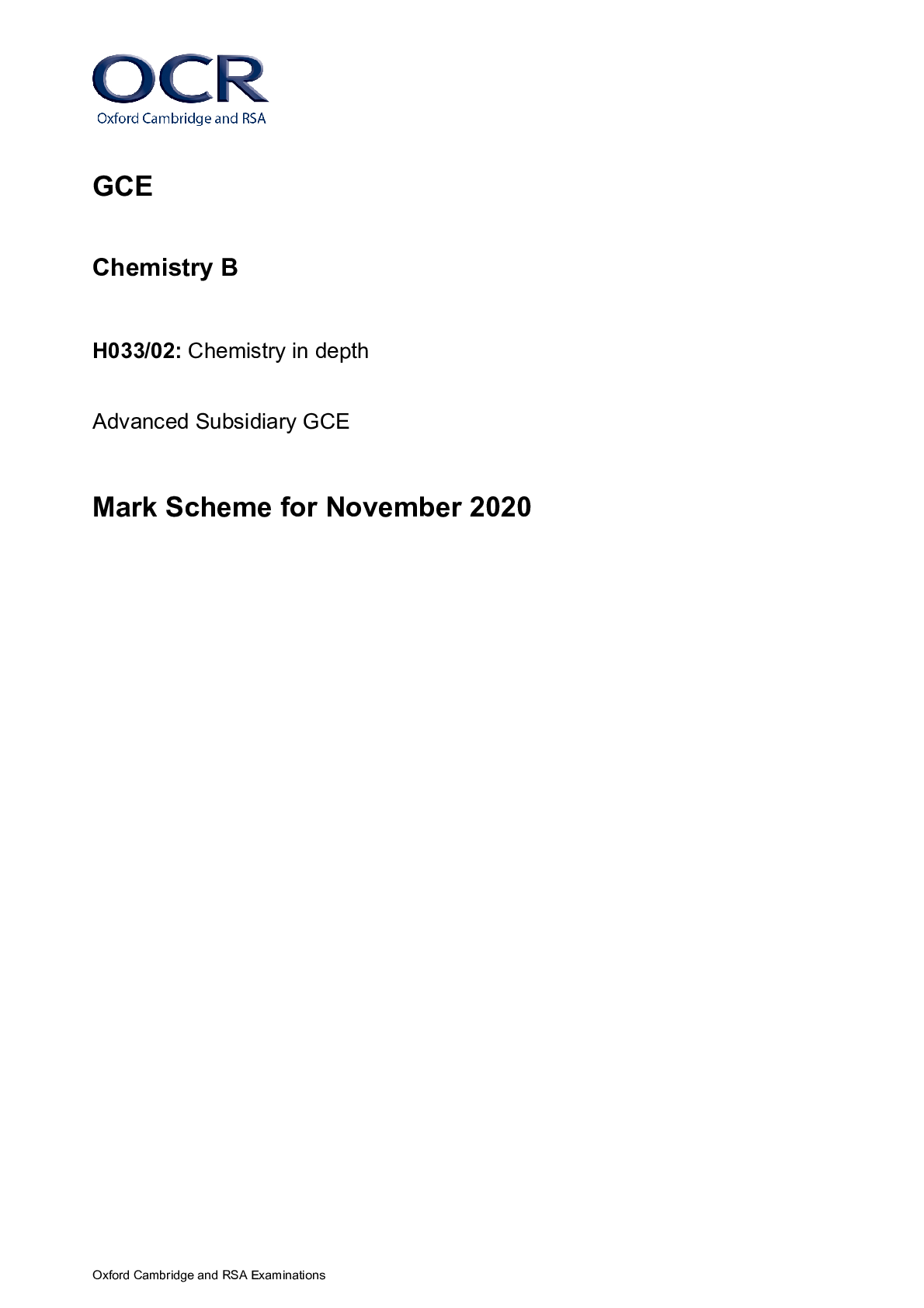
Reviews( 0 )
Document information
Connected school, study & course
About the document
Uploaded On
Oct 07, 2022
Number of pages
17
Written in
Additional information
This document has been written for:
Uploaded
Oct 07, 2022
Downloads
0
Views
33



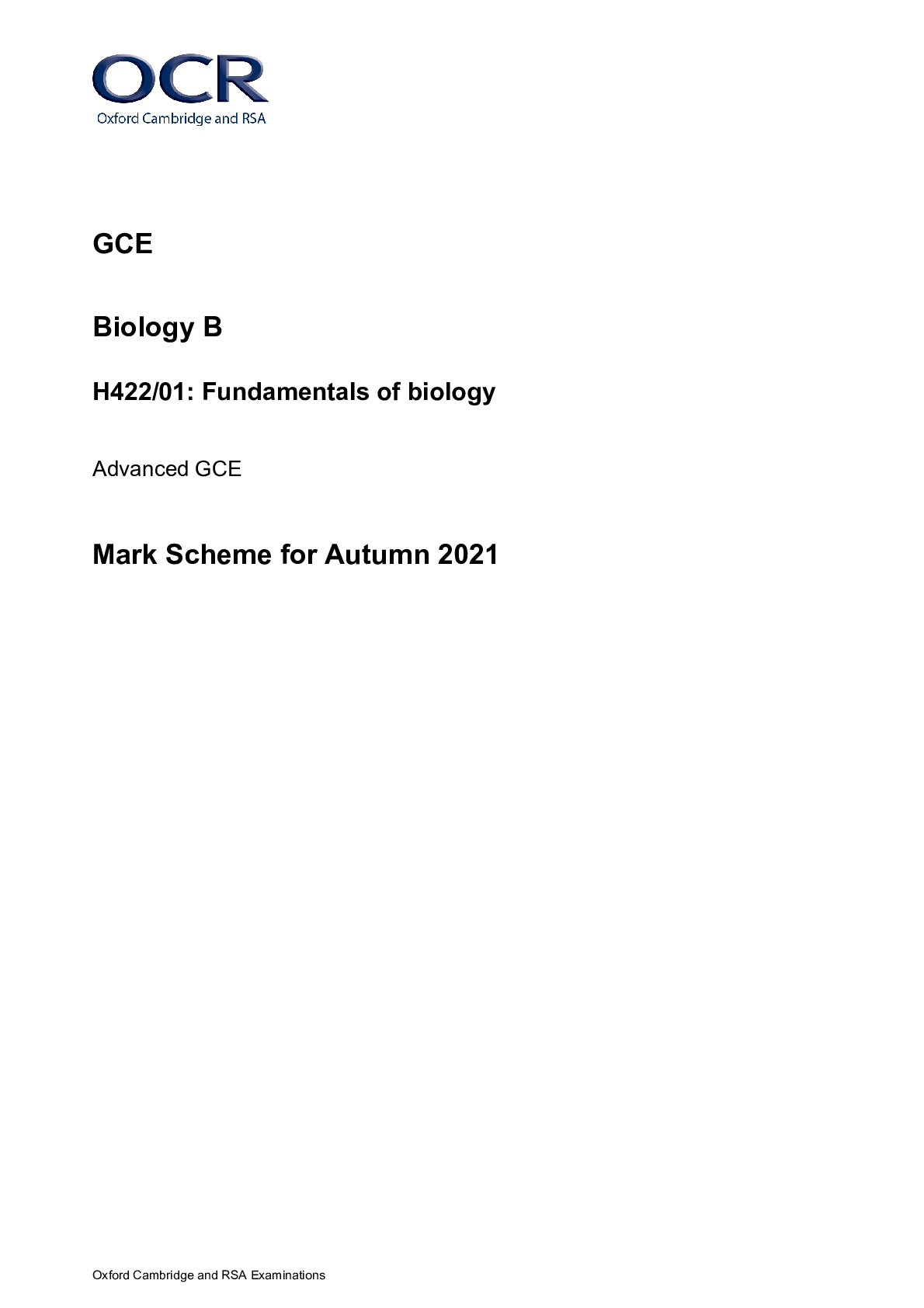
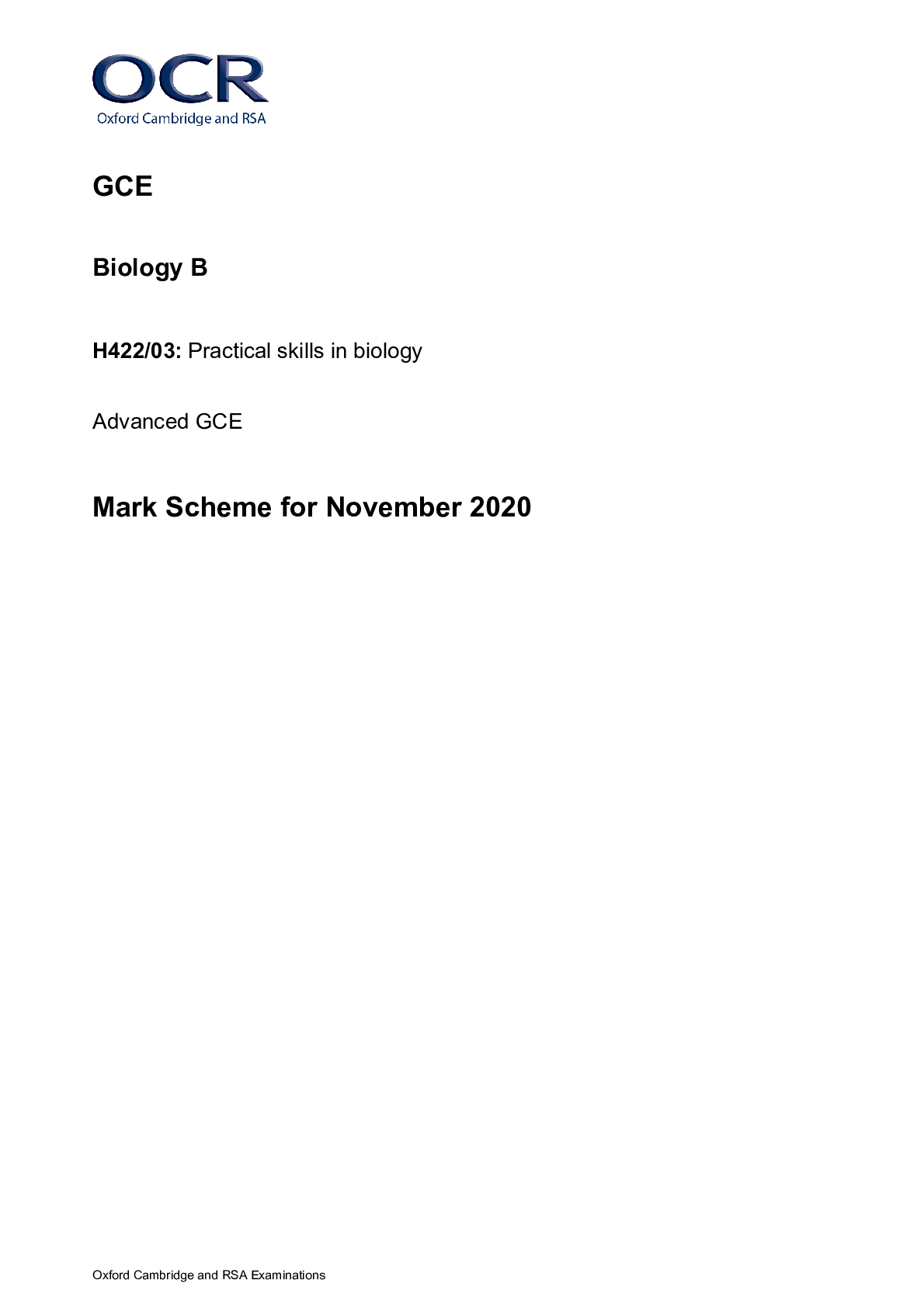
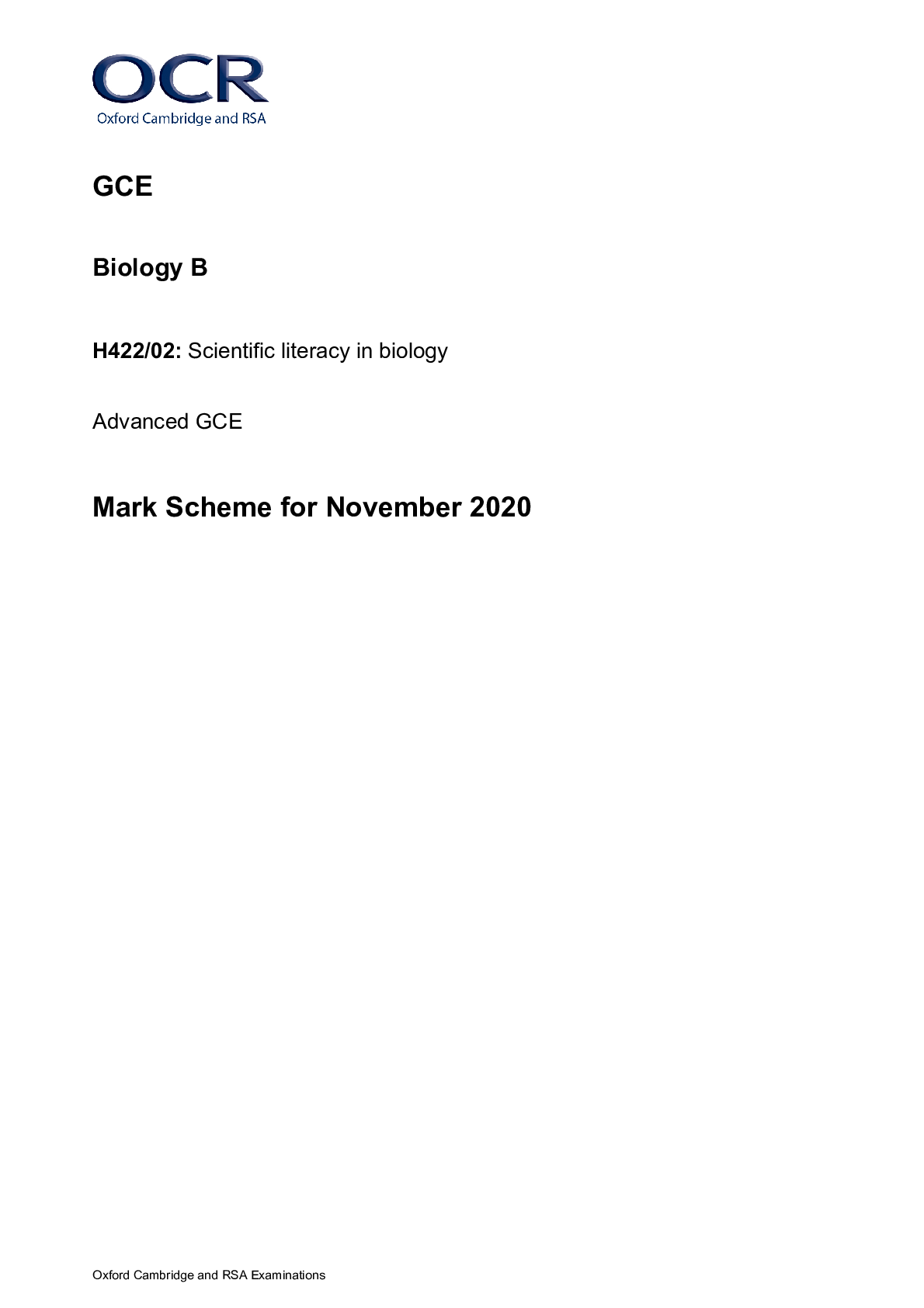
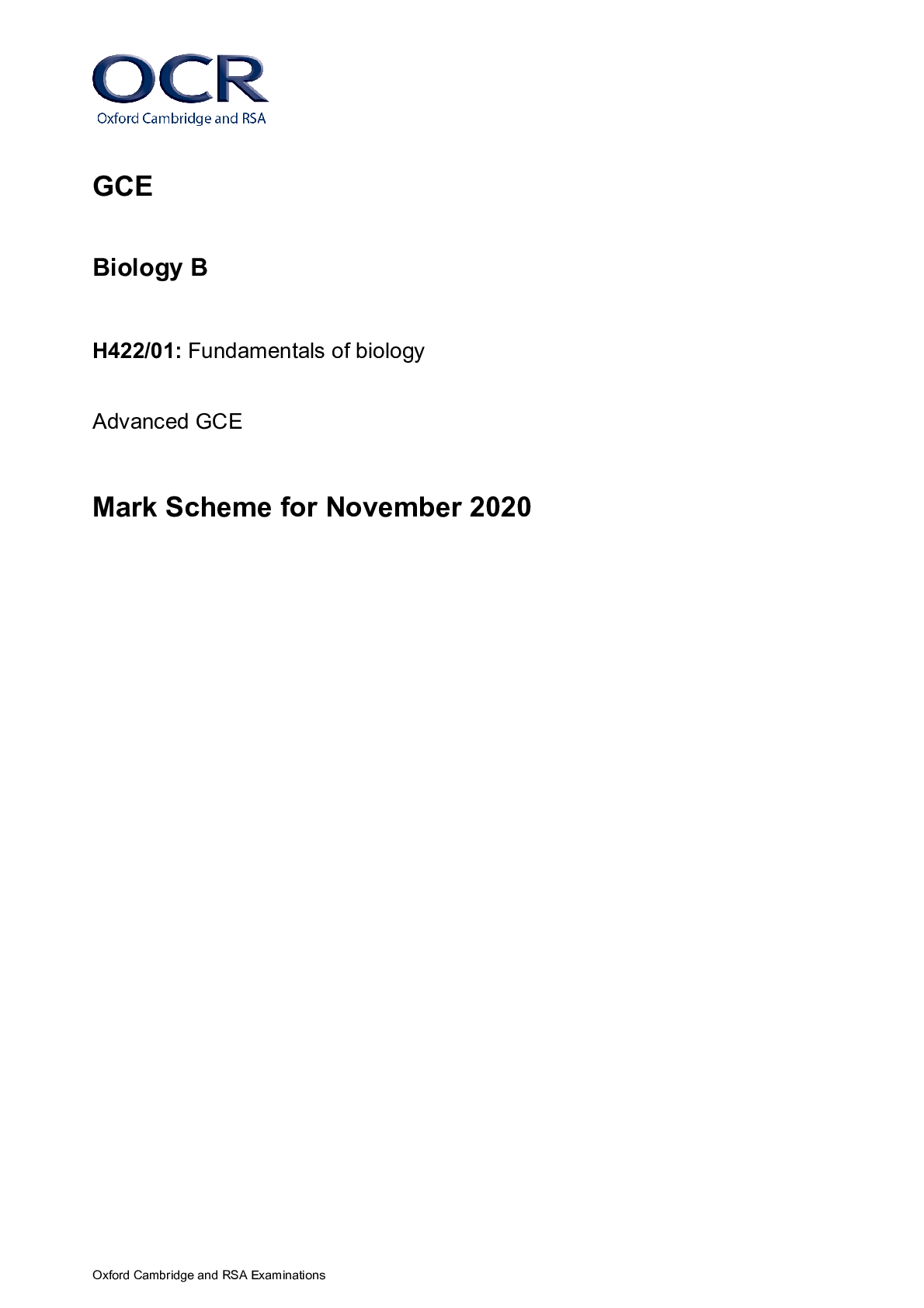

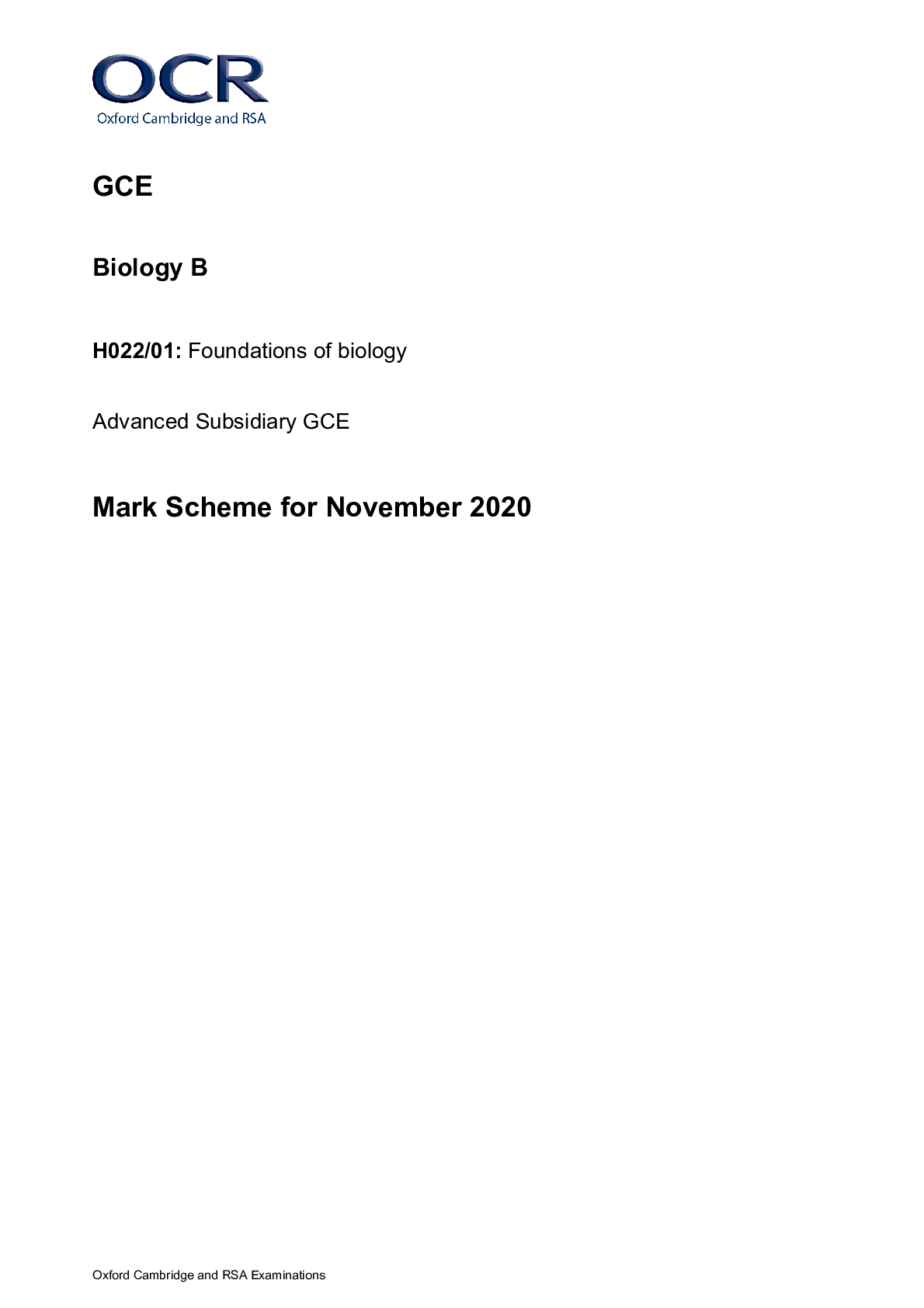
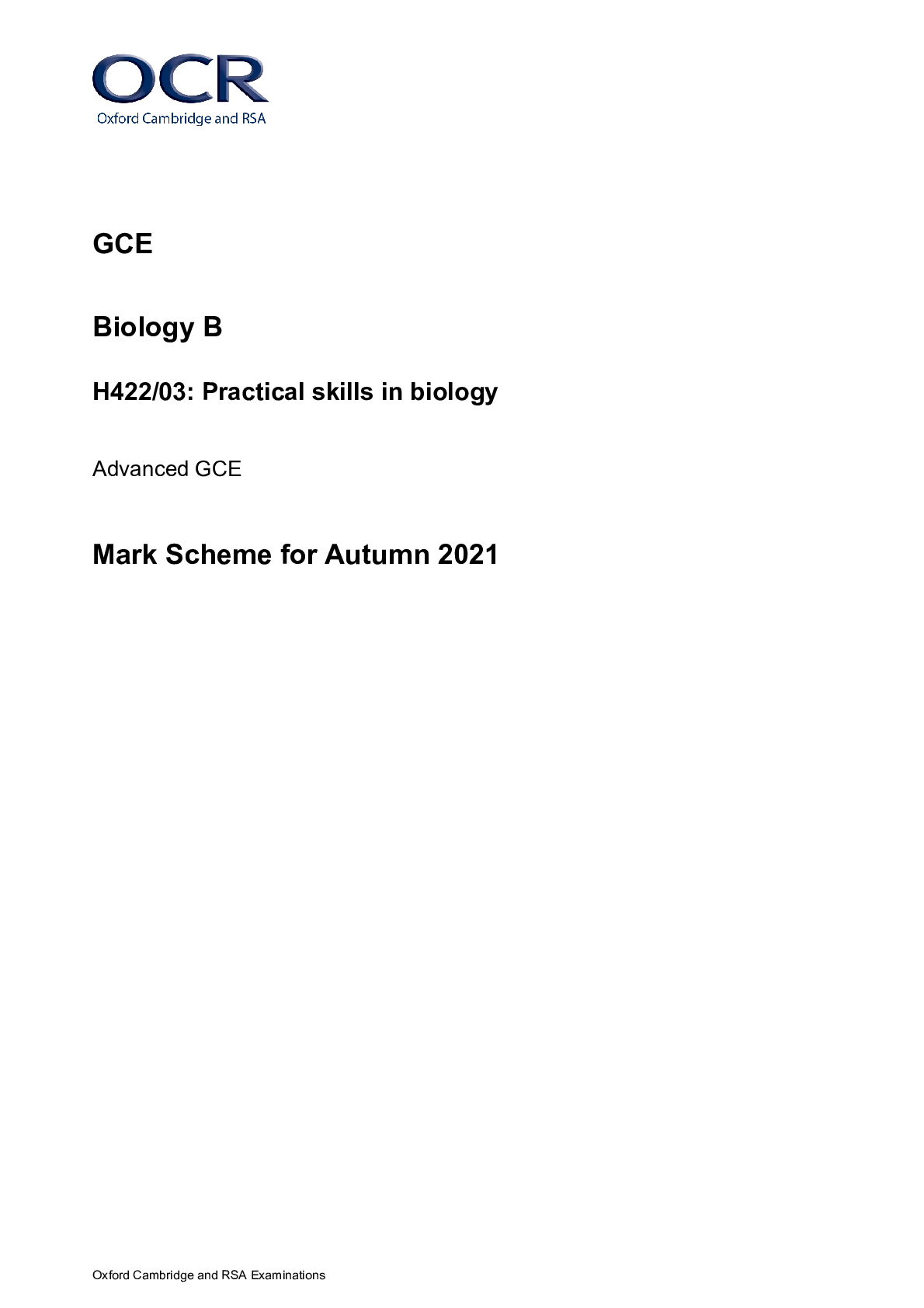
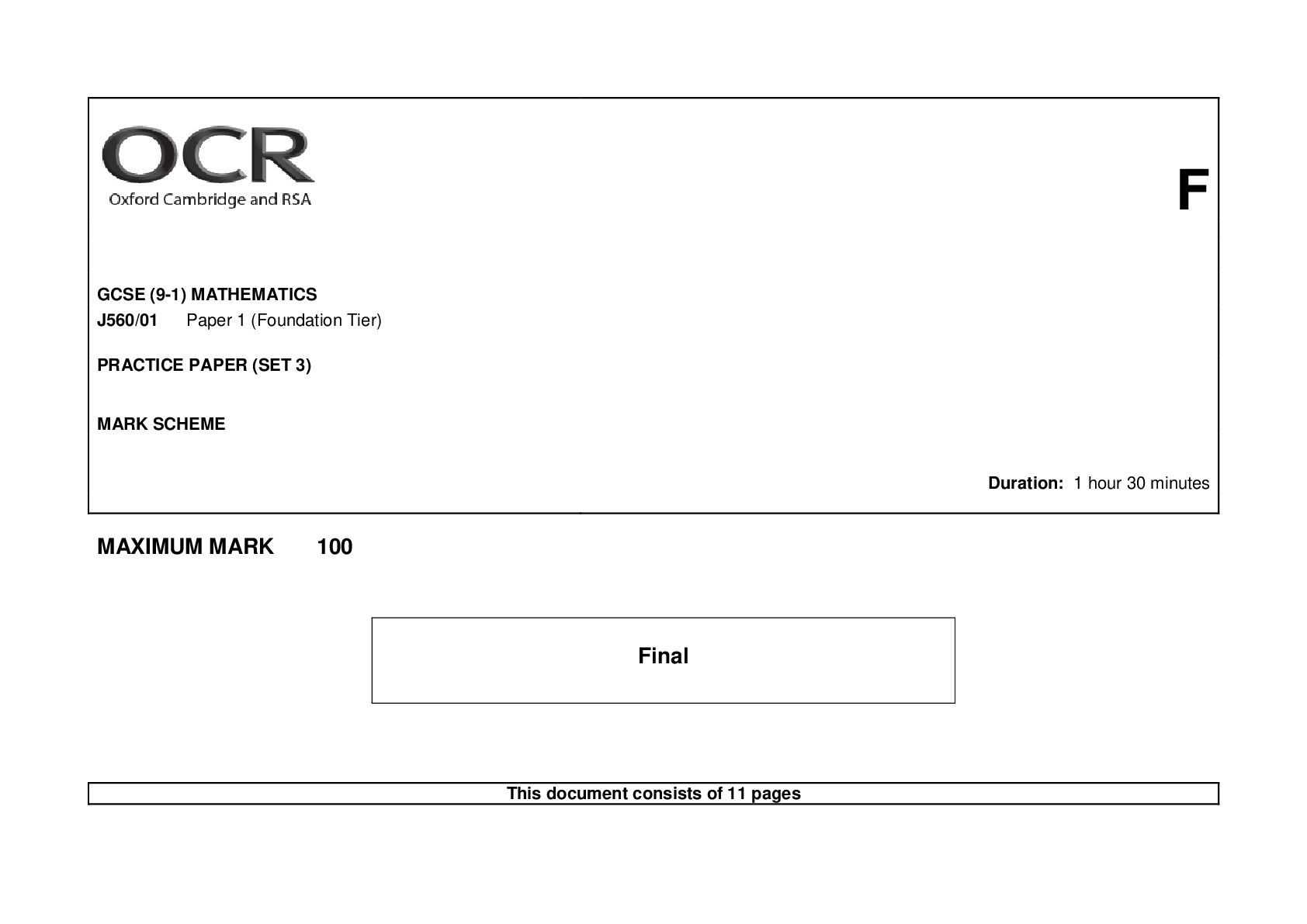
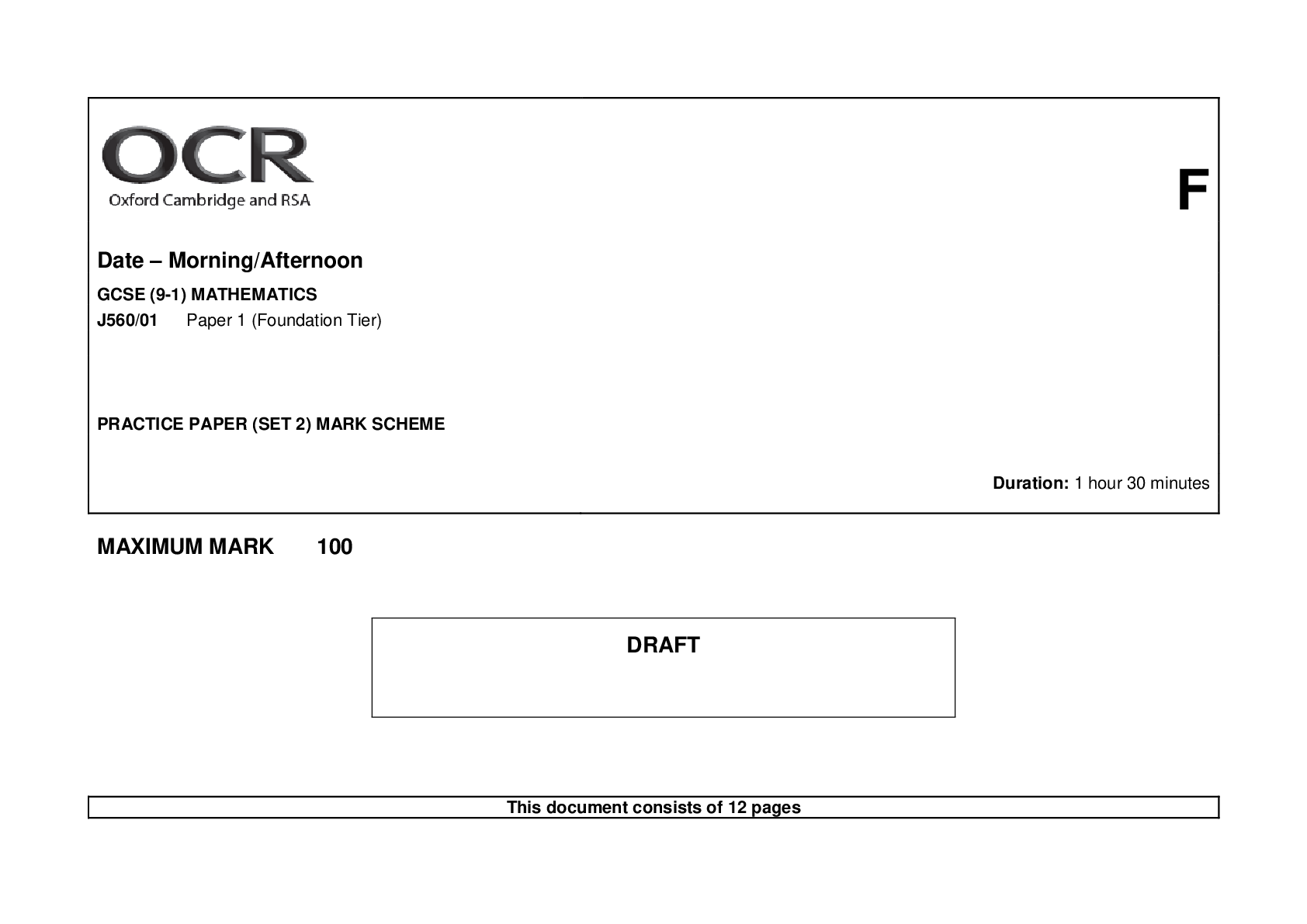
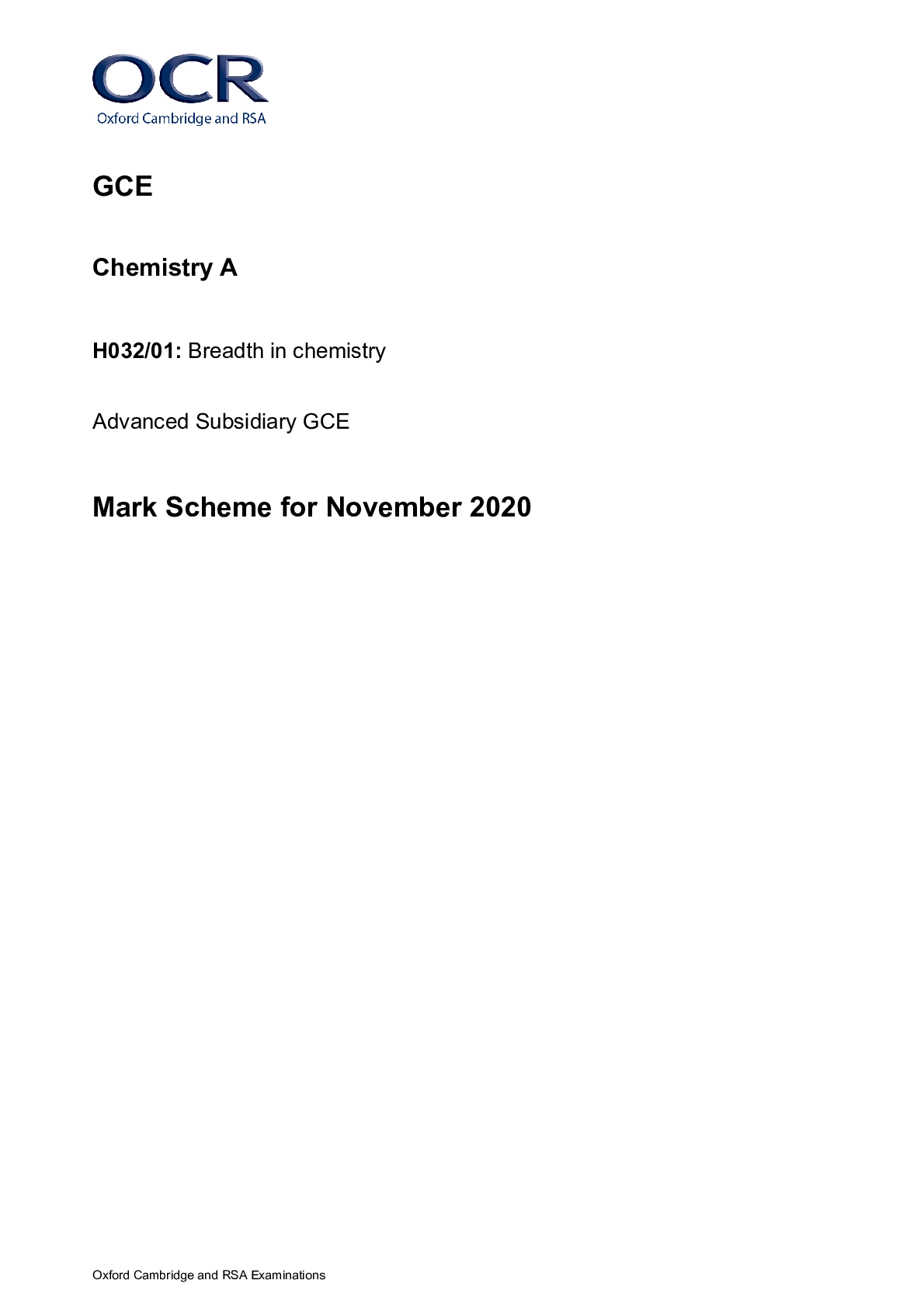

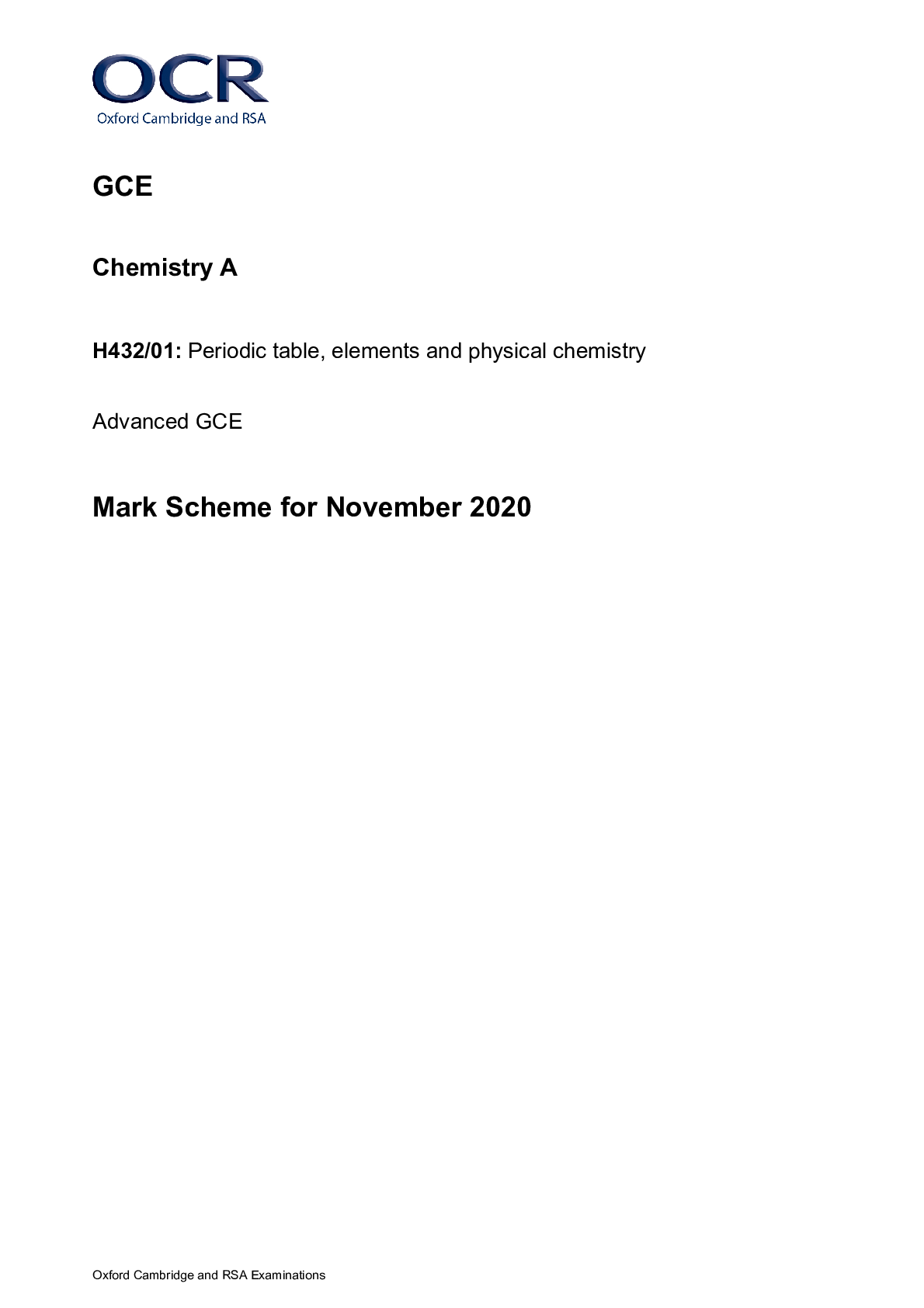
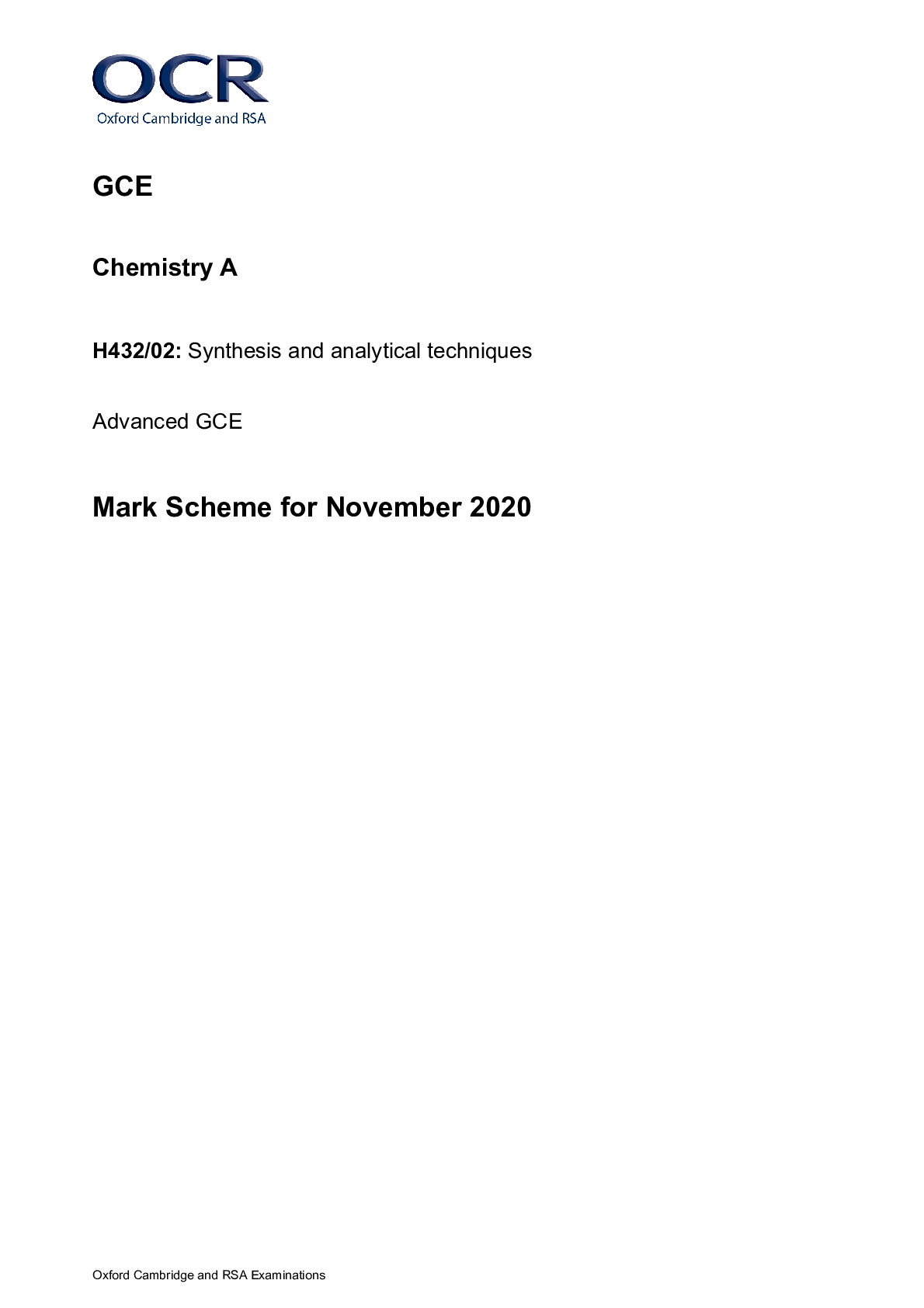

H630-02 Pure Mathematics and Statistics Advanced Subsidiary GCE Mark Scheme for Autumn 2021.png)


.png)
